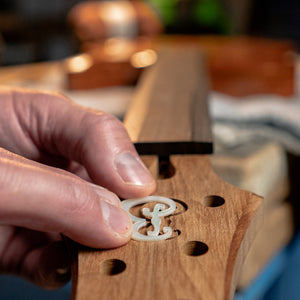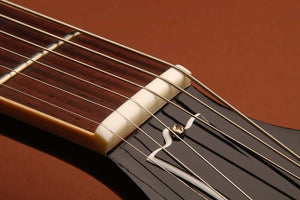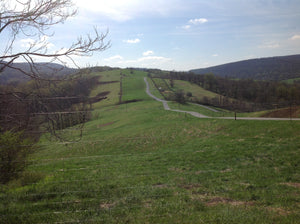
There are many different properties of wood that affect the tone of an instrument. Everything from thickness of the wood, moisture content, physical structure, to the composition of the wood play into how your instrument will sound. Here’s a simple example to illustrate the varying properties of different woods. A very rubbery wood or flexible wood such as cork will deaden soundwaves as they pass through the spongy material, whereas a rigid and springy piece of wood will allow those same soundwaves to ‘ring’ through.

The Ripple Effect
Let’s take a step back from wood for the moment and imagine tossing a stone into a glassy smooth lake. What happens to the water’s surface when the stone hits the lake? It causes a set of ripples across the surface, right? Those ripples, or waves, travel uniformly across the water in perfect rings until they bounce off the shoreline or fade away in the distance. Now imagine a dock with pillars coming out of the water. What do those waves from your stone do when they hit the dock pillars? They break out into smaller waves, dissipate some, and deflect in different directions. In other words, the simple wave rings become more complex and distorted as they run into things like the dock pillars.
Now let’s take that wave principle and apply it to wood. When soundwaves hit different structures within the wood such as a knot or defect, the soundwaves will deflect and break up the same as the waves that hit the dock pillars. Luthiers can select woods with varying properties, which influence the notes you play, and in the process impart different character or color to your overall sound.

Since wood is an elaborate organic material, it accentuates and filters different frequencies to create rich complex sounds. Some woods are extremely straight, springy and uniform, and therefore allow soundwaves to travel easily and remain uniform, while other woods can be very wavy, dense, spongy or complex, which can filter certain frequencies, add unique undertones and even deaden the sound. There are many factors related to mechanical vibrations and resonant frequencies that we will not dive into here, but hopefully you agree with the basic principle that material choice and it’s composition affect how well different frequencies or soundwaves travel through the chosen material.
Is TONEWOOD A MYTH?
Whether you believe wood selection plays into the tone of an electric guitar or even believe that there is such a thing as a ‘tonewood’, hopefully we can all agree that certain woods are better suited for building instruments than others due to their natural stability, physical structure and beauty. (Read more about the Tonewood debate in this article).
Let’s look at this OG-Drop Semi-Hollow body. We think it sounds as beautiful as it looks, and is incredibly versatile. From the hand-shaped mahogany neck to the custom pickups and controls, this OG-Drop is hard to set down. We wanted to create a storied guitar that was not only visually beautiful, but wonderful to play, versatile, and full of complexity. To do this we decided to blend some of the best woods available from around the world that we felt would compliment each other, not only visually, but tonally as well. The model we chose was the OG Drop, which has classic offset looks, a beautiful feel, and fluid ergonomics.
Here’s Daniel Sproul of The Elephant Revival giving us his first impression of this OG-Drop Custom.
Watch DemoGuitar Specs
Ancient Kauri, Macassar Ebony & Honduran Mahogany Body
4A Flamed Koa Top (Hawaii)
Honduran Mahogany Neck
Cameroon Ebony Fretboard
Mother-Of-Pearl Inlay
Macassar Ebony Born Headstock Inlay
Lollar Custom Pickups (Humbucker, Single, Single)

Transitioning our focus to the neck, we decided to anchor this guitar in a rich and familiar heritage, one that was storied in music and legends, so we chose none other than the quarter-sawn Honduran Mahogany. As a neck wood, it delivers stability, strong meaty tone with beautiful mid-range and warmth, and it is a dream to work with in the shop. It’s straight fine grain carries notes down the neck with gorgeous timber and sustain, and rarely goes out of tune. To make a neck fit for rock gods we finished this off with a thick black Cameroon Ebony fretboard, adding attack, dynamic range, sustain and exquisite feel.

Unique & Extraordinary Woods
Now this guitar needed a body to match, and to work our way back around the world we chose one of the most beautiful and cherished woods on the planet, straight from Hawaii, Flamed Koa. Not only is Koa absolutely gorgeous, but it also resonates guitar frequencies with rich mid-range and top end clarity. With a thunderous mahogany neck, elegant ebony fretboard, and sexy and sultry koa top, we just needed to finish it off with something that would meld it all together, Ancient Kauri. Our 50,000 year old reclaimed Kauri from New Zealand would be the perfect match, melding timeless looks and tonal character together with its giant ancient figure and magical complexity gifted by father time, into a one-of-a-kind guitar with insane dynamic range.
The kauri that we use in our guitars is reclaimed from bogs in New Zealand. Kauri trees fell into these bogs over 50,000 years ago, not only preserving them but making the wood denser. Today this natural curing process makes ancient kauri about the density of mahogany. When we tapped this particular piece of Kauri, to get an idea of its tonality, it had such a fantastic blend in feel and tone. The Kauri had a slightly quicker attack than the mahogany we chose, along with great presence, beautiful warmth and subtle complexities that come with age.

Site Image: https://www.nzgeo.com/stories/swamp-kauri/
All of our guitars feature a press-fit neck joint binded together with custom machine bolts, and our proprietary neck heel relief. Together these features create the best of both worlds when it comes to neck design. Nothing is lost as the neck becomes one with the body, giving you excellent feel, sustain and tone all the way up the neck. Plus, if something ever happened to your guitar, then we can build you a replacement body or neck without sacrificing the undamaged components.

OUR CONCLUSION
So did all this planning ahead, careful selection of woods, and countless hours of fine lutherie make a better guitar? We think so. If our goal was to make a one-of-a-kind guitar, that not only looks beautiful, but also plays effortlessly and sounds killer, then we nailed it!
If you're curious about how different woods can alter the sound of your guitar, or if you have a specific sound in mind, we invite you to dive deeper into the world of guitar building with us.
Schedule an initial 30 minute Vision Call to discuss your guitar aspirations and explore the possibilities that our wood selection can offer.











